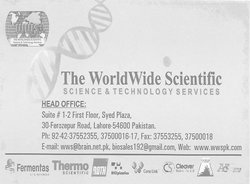Full Length Research Article
RETRACTED ARTICLE: N-cadherin protein-immuno-histochemical expression of the blood-testis barrier in male mice fed with diet minced with insecticide Bifenthrin
Mohammed Fawzi Faisal*, Haider Abdulrasool Jaafar
Adv. life sci., vol. 10, no. 4, pp. 593-599, December 2023
*- Corresponding Author: Mohammed Fawzi Faisal (mohammadfawzi997@gmail.com)
Authors' Affiliations
[Date Received: 28/07/2023; Date Revised: 30/08/2023; Date Published: 31/12/2023]
Abstract![]()
Introduction
Methods
Results
Discussion
References
Abstract
Background: Testis play role as endocrine organ by regulate and synthesis of hormones, and genital role as germ sells production (spermatogenesis) for reproduction process. The Sertoli cells in the seminiferous tubule with basal lamina and endothelium of vesicles, form a special structure called blood-testis-barrier (BTB) withe protection function and specific properties that similar to blood tissue barriers of other body organs.
Methods: Forty male healthy Swiss albino mice weighing 24-30 g will be kept in 2 groups (20 for each) in the labs of Al-Nahrain University College of medicine for 6 weeks from 1 December 2022_15 Jan 2023. Regular rodent food and water will be provided and Grouping as: Group A food minced with concentration of 400mg/kg of Bifenthrin insecticides and Group B have normal food.
Results: The histological study showed partial depletion testis cells in all mice testes with non-significant decrease in interstitial space that has Leydig cells between seminiferous tubule (ST) in testis of male mice that were fed with Bifenthrin diet. There were less cadherin expression in the BTB indicating that the Bifenthrin has stressful stimulus to potentiate apoptosis in the genital and somatic (Sertoli) cells of the testis that eventually impact the cadherin protein. The Bifenthrin has as stimulant chemical factor for more apoptosis in the ST cells death with subsequently testicular atrophy and subsequently infertility. The Bifenthrin treated male mice shows significant diminish positive values of N-cadherin expression that appear as less brown coloration of immunohistochemical biomarker expression of N-cadherin in the ST cells of the testis that was best evaluated by applying Aperio software program.
Conclusions: The N-cadherin protein has pivotal role in regulation the adhesiveness of the germinative-epithelial cells in ST of the testis. The Bifenthrin insecticides as an endocrine disrupter material has great effects on spermatogenesis and tissue damage.
Keywords: Bifenthrin insecticides; N-cadherin; Spermatogenesis; Sertoli cells; Leydig cells; Seminiferous tubule; Basal lamina; Blood-testis barrier
Retraction Note
24 Sept 2025: The Editor-in-Chief has retracted this article due to the below mentioned scientific deficiencies revealed by an internal audit.
1. This paper contains direct contradictions between the narrative in the results text and the data presented in Table 1.
- The text explicitly states that the difference in interstitial space was "non-significant value (p values > 0.05)". However, Table 1 reports a p-value of "0.05*", indicating the result was statistically significant.
- The text, abstract, and figures all argue that N-cadherin expression decreased in the treated group. However, Table 1 shows a mean value of 120,595 for the treated group, which is double the value of 60,353 for the untreated group. This suggests the values for the treated and untreated groups were swapped in the table, a critical data-reporting error that reverses the finding.
2. The results section contains a completely irrelevant paragraph about drug safety in a human patient treated with G-CSF. This appears to be a major copy-paste error from an unrelated manuscript and severely damages the credibility of the document.
3. The images intended to show histological damage in the treated group (Figure 1B and Figure 2B) are of extremely poor quality. They are blurry and out of focus to the point that no cellular or tissue structures are discernible, making it impossible for the reader to verify the authors' claims of testicular damage.
The authors have not responded to correspondence regarding this retraction.



